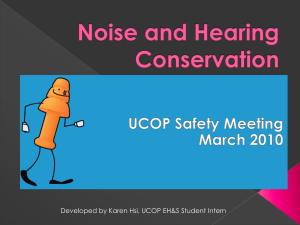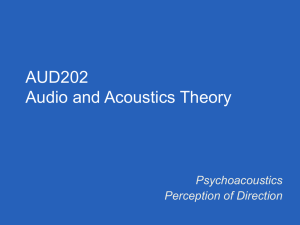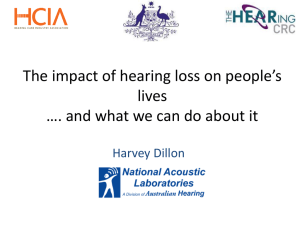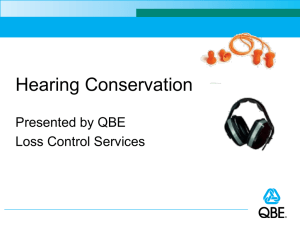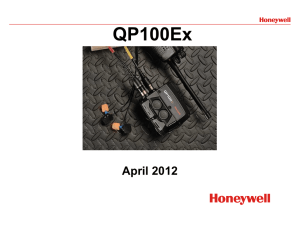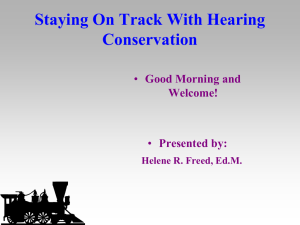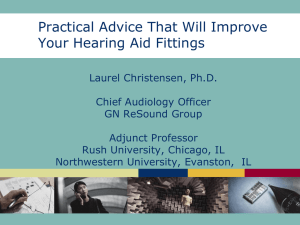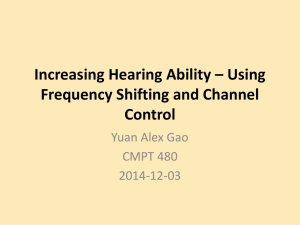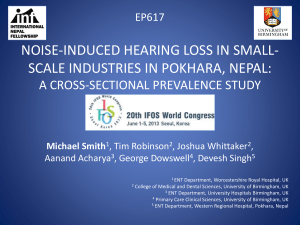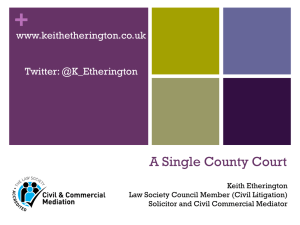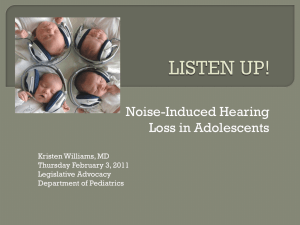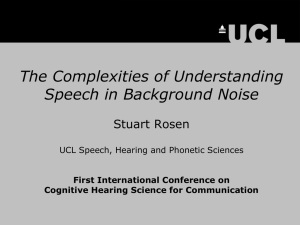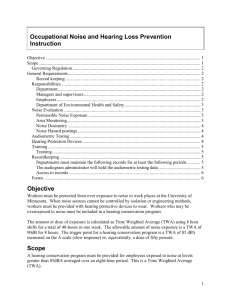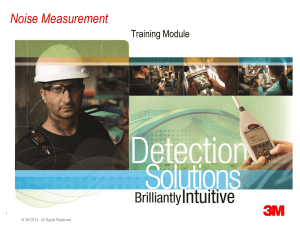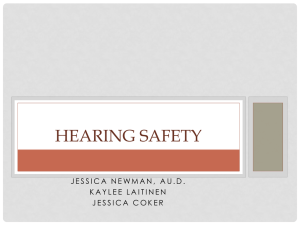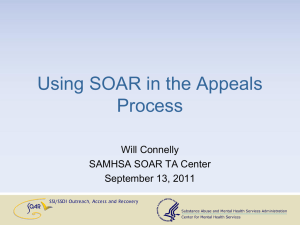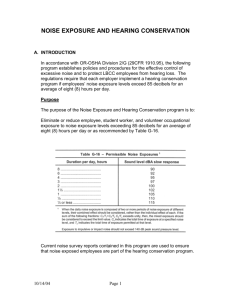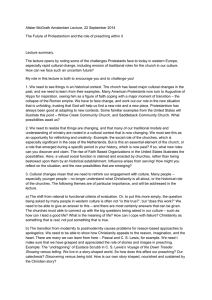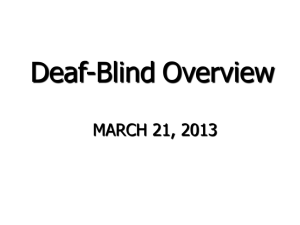Why are Praise Bands so Loud?
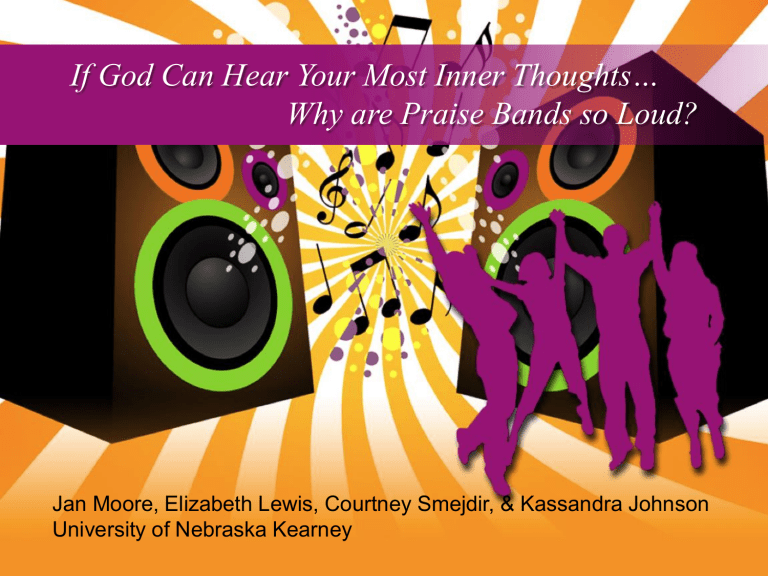
If God Can Hear Your Most Inner Thoughts…
Why are Praise Bands so Loud?
Jan Moore, Elizabeth Lewis, Courtney Smejdir, & Kassandra Johnson
University of Nebraska Kearney
Disclosures
• Jan Moore is a Professor at UNK
– Treasurer for Academy of Rehabilitative
Audiology
• UNK provided standard faculty and student travel funding to attend ASHA
• No funding or support to conduct the study
• No commercial ties to industry
• No conflicts of interest
Research Team
• Jan Moore
– Professor, University of Nebraska Kearney
• Elizabeth Lewis
• Courtney Smejdir
• Kassandra Johnson
– All undergraduate student researchers at the time of the study
– All graduate students at UNK or UNL
Background
• Contemporary or Praise Band services have been an increasingly popular worship style for Protestant faiths over the last 20 years.
• Gone are the days of an acoustic guitar and “Michael Row the Boat Ashore”
• Now we have full-fledged rock bands at worship services
Pertinent Background
• Noise-induced S/N hearing loss has been well documented in
– Rock musicians
– Orchestral musicians
– Band musicians
– Just living in NYC
• Silva & Cabral (2011) found priests in
Brazilian churches were are risk for hearing loss due to noise levels.
How Churches Respond to
Concerns about Sound Levels
• A quick search of the internet yields considerable interest in this topic within the Church community.
– Churches consistently tell members the music level does not exceed OSHA standards
• 5 dB rule (time/intensity trade off) in contrast to a 3 dB rule recommended by the NIOSH/CDC
• How do they know that?
• Do they monitor their members’ hearing overtime?
• Churches blame their members
– “If it is too loud for you there is something wrong with your hearing.”
• Churches say “discomfort” does not mean
“harm.”
• Churches actually provide hearing protection
• One church calculated that one service was 13% of the daily OSHA dose
– Average dose was 9—11%
– Clergy and band was 35% of their dose for 2 services.
– Why would you want your service to contribute anything to someone’s daily dose?
• On a very personal note, I wrote to my church and expressed my concern about the loudness level.
– If mothers are trying to cover their infant’s ears during a service, it is just too loud.
– Minister exceeds 90 dB A during the sermon
– The wooden pews vibrate during the music
Public Health Issue
• We are interested in investigating the risk of hearing loss in praise band members, clergy, and parishioners (including children) who attend these services.
• NIH’s It’s a Noisy Planet public health initiative suggests any exposure above 85 dB (A) can lead to hearing loss over time.
• Our team looks at exposure to noise in churches as a public health issue
Noisy Planet
CDC —NIOSH
UNK Praise the Lord Project
• Does the noise level at contemporary services suggest there is a risk for permanent S/N hearing loss consistent with noise exposure?
• What are the challenges in measuring noise in the contemporary services
UNK Praise the Lord Project
• Do parishioners, clergy, and other worship staff exhibit a change in hearing (TTS) following these services?
• Is there long-term hearing loss over time?
• What is the best method to detect change?
Method
• The noise levels of 3 Protestant church services were sampled
– UNK Christian Student Fellowship (CSF)
– First United Methodist Church (FUMC)
– Evangelical Free Church (E-Free)
• Services were recorded in the fall during the liturgical season of After Pentecost
– Covert recordings
– Multiple recordings at each site
Method
• No special services (Easter, Christmas)
• Catholic Church services were excluded due to the standardization of their order of worship
• Contemporary Services typically have
– More music
– Longer durations of continuous music
• Dosimetry
• LENA
Dosimetry
• Quest Noise Pro TM Dosimeter
– 2-hour run time
• Individual sessions for songs to try to isolate the contribution of the music to the noise levels measured
– Slow time response
– Calibrated
– Obtained Min, Max, Average and Dose information for each service
LENA
TM
• Language Environmental Analysis
– LENA Research Foundation
– Boulder, CO
• Lena Pro digital recorder
– Application is in language development
• Adult words, child words, turn-taking
– Records time spent in noise and electronic media
– 5-minute intervals for analysis
Dosimetry Results: Full Service Max &
Average
Church
CSF
Efree
FUMC
Duration Maximum dBA Average dBA
1:08:53 107.2 84.4
46:06
47:06
1:16:40
58:00
108.1
106:0
92:4
97.0
66.5
78:3
74.5
77.7
49:17
1:08:09
1:08:09
1:00:00
1:10:00
97.4
97.7
97.7
96.6
114.2
79.5
82.3
78.6
77.7
73.5
Dosimetry Results: Individual Songs
Church
CSF
Efree
Duration Maximum dBA Average dBA
6:15 93.1
78.4
11:13
7:54
7.26
6:59
103.2
100.1
106.0
94.2
91.8
67.6
75.8
78.8
5:37
5:12
4:18
2:07
93.6
93.2
93.4
112.6
79.3
72.8
80.1
94.3
Lena Results
• Lena was utilized in one service to look at noise segments in 5-minute intervals.
• Over half of the service—30 minutes— was music.
– Essentially a concert.
Lena Results
• Lena also allows the measurement of the signal in the 5-minute intervals
• The dB levels as recorded by Lena indicated levels exceeded 85 dB A for all segments
• Compression within the microphone of the digital recorder.
– Designed for speech not noise
Results
• Our results suggest the loudness levels in contemporary services puts people at risk for N/I S/N hearing loss
• Who is at risk?
– Clergy
– Band members
– Parishioners
• How often do you attend?
Challenges
• How to measure the parts of the services which are loud?
• Duration of the music?
• How do we measure change in hearing?
– Which methods?
• Conventional audiometry?
• OAE?
– How often?
• Pre-Post
• Yearly
What is the Public Health
Message?
• We can’t control much of the noise we are exposed to in our lives
• The environments that we can control should be safe
• Institutions should be committed or at least interested in not contributing to N/I
S/N hearing loss.
• Those environments would include schools, churches, & public places
Comments?
• Suggestions?
• Questions?
• mooreja2@unk.edu

